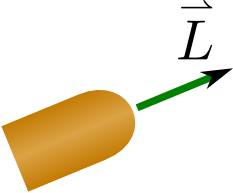Spinning bullets
Posted by David Zaslavsky on — CommentsWhile catching up on some old Mythbusters episodes, I ran across an interesting myth about spinning bullets. Apparently when you shoot a bullet into the surface of a frozen lake, it bounces backward, bounces over the ice a little way, and keeps spinning even after it comes to rest.
This is a very curious result. At first, it kind of seems to make sense. A bullet comes out of the gun spinning at 80000 revolutions per minute, according to the show, which is pretty fast. So it makes sense that it has a sizable amount of angular momentum, which in turn means it’ll take quite a bit of torque to stop it. Colliding with the ice conceivably might not be able to exert enough torque to do that, so the bullet would keep spinning.
But if that were the case, the bullet should maintain its orientation — it’d keep pointing in the same direction that it came out of the gun, because angular momentum is a vector quantity and it won’t change in either magnitude or direction without an external torque. That clearly wasn’t the case; the bullets the Mythbusters shot skittered across the ice, spinning in multiple directions, and landed with an orientation completely different from what they had when they were shot. How does that happen?

I’m not entirely sure what actually goes on with these spinning bullets, but I think the key lies in the direction of the torque exerted. Like angular momentum, torque is a vector quantity. In order for a torque to stop the bullet, it needs to point directly antiparallel to the angular momentum, but when a bullet collides with ice, the collision is quite complicated and there’s no reason to expect that the net torque will point neatly along the angular momentum axis.
There are two main sources of torque that I can think of: friction between the edge of the bullet and the ice, and impacts between the bullet and fragments of ice that are flying around in the aftermath of the collision. The friction would certainly contribute to slowing the bullet’s rotation, but the impacts would be more or less random, so they could conceivably create the right kind of torque to change the orientation of the spin without necessarily slowing it down. Plus, I can imagine that the torque provided by friction may not be all that much — after all, ice is slippery, and besides, the bullet bounces out (and is no longer touching the ice) after a very short time. If the impacts provide much more torque than the friction, it would account for the tumbling behavior you can see in some of the high-speed excerpts they put in the show, and it would also explain why the bullet keeps spinning as it bounces around the ice.